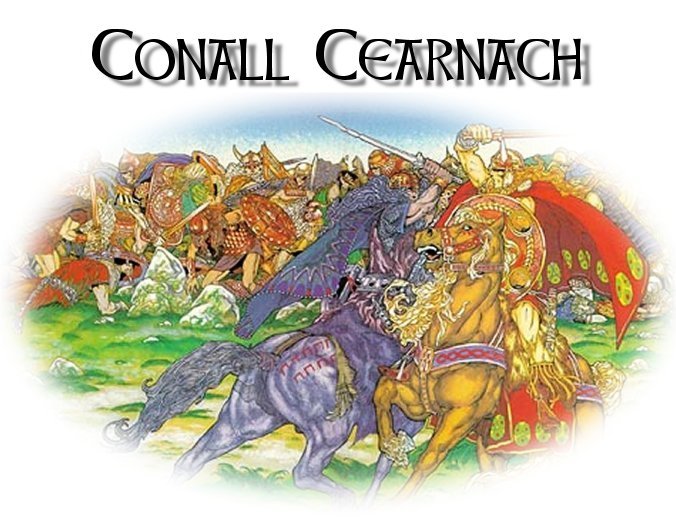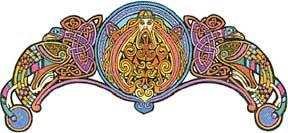|
 Conall Cearnach was the son of Amergin, the chief "bard" or poet of the
Milesians, and Fionnchaem, daughter of Cathbad the druid.
Conall means "strong
as a wolf", and Cearnach means "victorious". It was he who was responsible for
avenging the death of his friend
and fellow warrior,
the great Cúchulainn, or
"The Hound of Ulster" as he was known.
Conall was himself slain by the Connaughtmen, from the west of Ireland, who
were mortal enemies of the men of Ulster in the 1st century A.D.
It was he who
had been responsible for killing their king at some previous time, and understandeably they were somewhat upset with him on account of this.
Conall Cearnach was the son of Amergin, the chief "bard" or poet of the
Milesians, and Fionnchaem, daughter of Cathbad the druid.
Conall means "strong
as a wolf", and Cearnach means "victorious". It was he who was responsible for
avenging the death of his friend
and fellow warrior,
the great Cúchulainn, or
"The Hound of Ulster" as he was known.
Conall was himself slain by the Connaughtmen, from the west of Ireland, who
were mortal enemies of the men of Ulster in the 1st century A.D.
It was he who
had been responsible for killing their king at some previous time, and understandeably they were somewhat upset with him on account of this.

 The place at which he died is called Ballyconnell, a small town in County
Cavan, quite near to the border with the present "Northern" Ireland.
It takes
its name from the anglicised "Baile Chonaill", meaning the town of Conall. No
doubt he put up a brave fight to the very end,
since he was considered
the
foremost of the champions of Ulster, but was probably overcome by sheer weight
of numbers.
He was alone and far from the assistance of his fellow Red Branch Knights when he died...
The place at which he died is called Ballyconnell, a small town in County
Cavan, quite near to the border with the present "Northern" Ireland.
It takes
its name from the anglicised "Baile Chonaill", meaning the town of Conall. No
doubt he put up a brave fight to the very end,
since he was considered
the
foremost of the champions of Ulster, but was probably overcome by sheer weight
of numbers.
He was alone and far from the assistance of his fellow Red Branch Knights when he died...

 There is a very interesting story about Conall having been in Jerusalem on the
day that Christ was crucified, and this is taken as fact by the Moores
(O'Mores),
and the Magennises, as both clans claim descent from this
legendary warrior. It is held as true to this very day by people
living in
the Glens of Antrim, since it was on the coastline of this county that Conall's
castle of Dunseverick was situated.
In an account of the funeral of John Mackuey, of Carnagh, Queen's County (the
present-day County Laois) who is said to have been descended
from the O'Mores
or Moores of that same county, we read:
There is a very interesting story about Conall having been in Jerusalem on the
day that Christ was crucified, and this is taken as fact by the Moores
(O'Mores),
and the Magennises, as both clans claim descent from this
legendary warrior. It is held as true to this very day by people
living in
the Glens of Antrim, since it was on the coastline of this county that Conall's
castle of Dunseverick was situated.
In an account of the funeral of John Mackuey, of Carnagh, Queen's County (the
present-day County Laois) who is said to have been descended
from the O'Mores
or Moores of that same county, we read:
"The crest is a man slaughtering his enemies
and cutting off their heads,
and with a sword full of their heads.
This man was Conall Cearnach, my ancestor."
---- signed, Roger Moore

 At the time of the funeral mentioned above (probably sometime in the 18th century),
it was the custom to display the armorial banner of the deceased person's
clan
within the church where the service was being held, hence the reference to the
crest. The Moore/O'More crest is shown here, along with that
of the
Magennises,
and as you can see, each has the golden "lion rampant" of the
Milesians on what is known as the "field" in heraldic terms..
At the time of the funeral mentioned above (probably sometime in the 18th century),
it was the custom to display the armorial banner of the deceased person's
clan
within the church where the service was being held, hence the reference to the
crest. The Moore/O'More crest is shown here, along with that
of the
Magennises,
and as you can see, each has the golden "lion rampant" of the
Milesians on what is known as the "field" in heraldic terms..

Update: December 10th 2005: I found the information below while researching on the Internet
just a few evenings ago. I intend to visit
the location described as soon as time allows, and take some photographs. These will be published on the site shortly afterwards.
Bellaheady Cairn: Three miles south west of Ballyconnell, not far from the Shannon - Erne Waterway, is a heap of stones marking the site of a
prehistoric burial. This may be over three thousand years old. According to tradition, this is the spot where the legendary Conall Cearnach,
who gave his name to Ballyconnell, is buried.
|
![]()


![]()